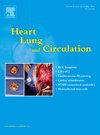Validation of a Prediction Model From Quantitative Coronary Angiography to Detect Ischaemic Lesions as Evaluated by Invasive Fractional Flow Reserve
IF 2.2
4区 医学
Q2 CARDIAC & CARDIOVASCULAR SYSTEMS
引用次数: 0
Abstract
Aim
Physician visual assessment (PVA) in invasive coronary angiography (ICA) is clinically used to determine stenosis severity and guide coronary intervention. However, PVA provides limited information regarding the haemodynamic significance of stenosis. This prospective study aimed to develop a model combining visual diameter stenosis (DSPVA) and quantitative coronary angiography (QCA)-derived parameters to diagnose ischaemic lesions using invasive fractional flow reserve (FFR) with pharmacologically induced maximal hyperaemia as the gold standard.
Methods
A total of 103 patients (148 lesions) who underwent ICA and FFR measurement were included in the study. Quantitative coronary angiography was used to evaluate various parameters, including anatomical parameters such as lesion length (LL), minimal lumen diameter (MLD), and minimal lumen area, along with haemodynamic parameters like LL/MLD4 and stenotic flow reserve (SFR). Plaque area, a characteristic parameter of plaque, was also assessed. Lesion-specific ischaemia was defined as invasive FFR ≤0.8.
Results
The LL/MLD4 (r= 0.66, p<0.001) and SFR (r=0.66, p<0.001) exhibited inverse and positive correlations, respectively, with invasive FFR. In the multivariable logistic regression analysis, LL/MLD4 (≥10.6 mm-3 vs <10.6 mm-3; Odds ratio [OR] 10.59, 95% confidence interval [CI] 3.94–28.50; p<0.001) and SFR (≤2.85 vs >2.85; OR 4.38, 95% CI 1.63–11.79; p=0.004) were identified as the optimal dichotomised predictors for discriminating ischaemia. The area under the curve (AUC) was 0.77 using DSPVA ≥70% as a single predictor. Adding LL/MLD4 ≥10.6 mm-3 and SFR ≤2.85 into the model significantly increased the AUC to 0.87 (p<0.001).
Conclusion
Incorporating QCA-derived haemodynamic parameters provided significant incremental value in the model’s discriminatory capability for ischaemic lesions compared with visual diameter assessment alone.
验证定量冠状动脉造影的预测模型,以检测有创分数血流储备评估的缺血性病变。
目的:有创冠状动脉造影(ICA)中的医生目视评估(PVA)在临床上用于确定狭窄严重程度和指导冠状动脉介入治疗。然而,PVA 提供的有关狭窄血流动力学意义的信息有限。这项前瞻性研究旨在建立一个模型,结合可视直径狭窄(DSPVA)和定量冠状动脉造影(QCA)得出的参数,使用有创分数血流储备(FFR)诊断缺血性病变,并以药物诱导的最大高血容量作为金标准:共有 103 名患者(148 个病变)接受了 ICA 和 FFR 测量。定量冠状动脉造影用于评估各种参数,包括解剖参数,如病变长度(LL)、最小管腔直径(MLD)和最小管腔面积,以及血流动力学参数,如 LL/MLD4 和狭窄血流储备(SFR)。同时还评估了斑块的特征参数--斑块面积。病变特异性缺血定义为有创 FFR ≤0.8:LL/MLD4 (r= -0.66, p4 (≥10.6 mm-3 vs -3; Odds ratio [OR] 10.59, 95% confidence interval [CI] 3.94-28.50; p2.85; OR 4.38, 95% CI 1.63-11.79; p=0.004)被确定为判别缺血的最佳二分预测因子。以 DSPVA ≥ 70% 作为单一预测因子,曲线下面积 (AUC) 为 0.77。在模型中加入 LL/MLD4 ≥10.6 mm-3 和 SFR ≤2.85 后,AUC 显著增加到 0.87(p 结论:与单纯的视觉直径评估相比,纳入 QCA 衍生的血流动力学参数可显著提高模型对缺血性病变的判别能力。
本文章由计算机程序翻译,如有差异,请以英文原文为准。
求助全文
约1分钟内获得全文
求助全文
来源期刊

Heart, Lung and Circulation
CARDIAC & CARDIOVASCULAR SYSTEMS-
CiteScore
4.50
自引率
3.80%
发文量
912
审稿时长
11.9 weeks
期刊介绍:
Heart, Lung and Circulation publishes articles integrating clinical and research activities in the fields of basic cardiovascular science, clinical cardiology and cardiac surgery, with a focus on emerging issues in cardiovascular disease. The journal promotes multidisciplinary dialogue between cardiologists, cardiothoracic surgeons, cardio-pulmonary physicians and cardiovascular scientists.
 求助内容:
求助内容: 应助结果提醒方式:
应助结果提醒方式:


